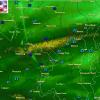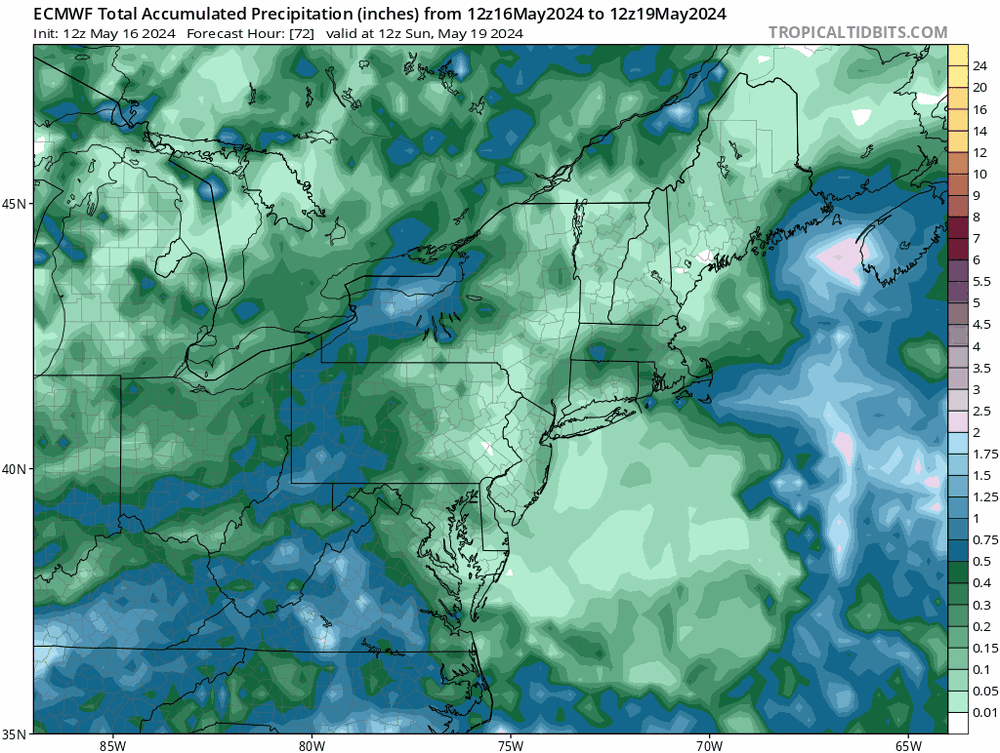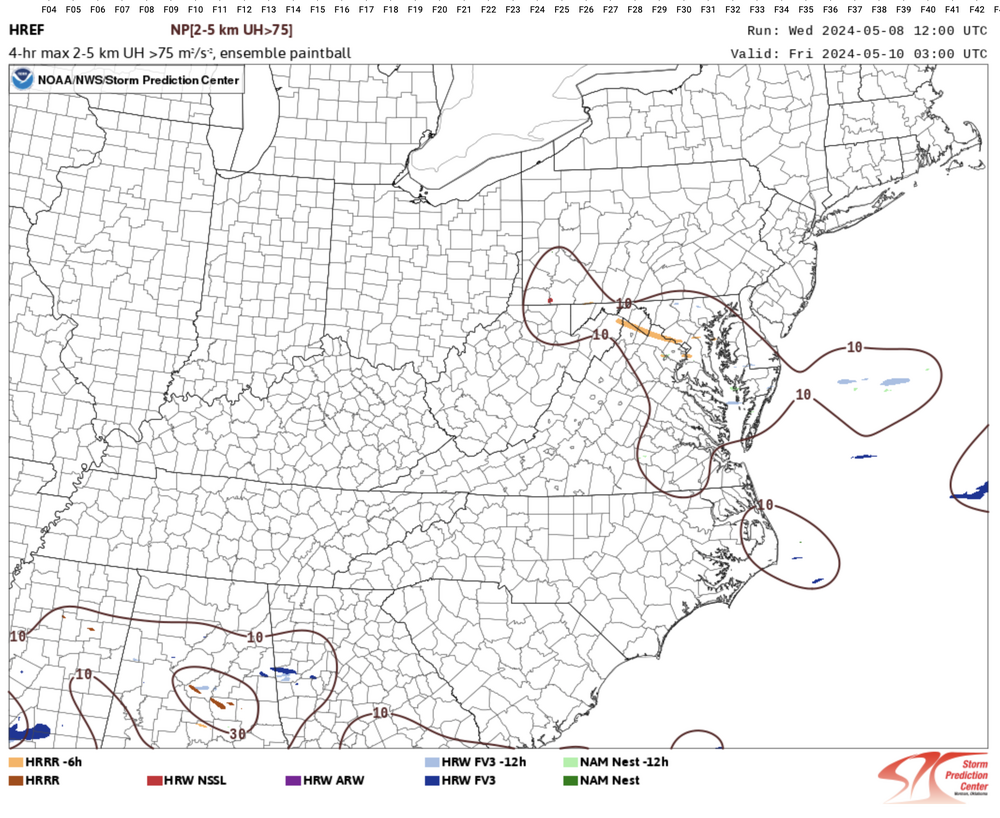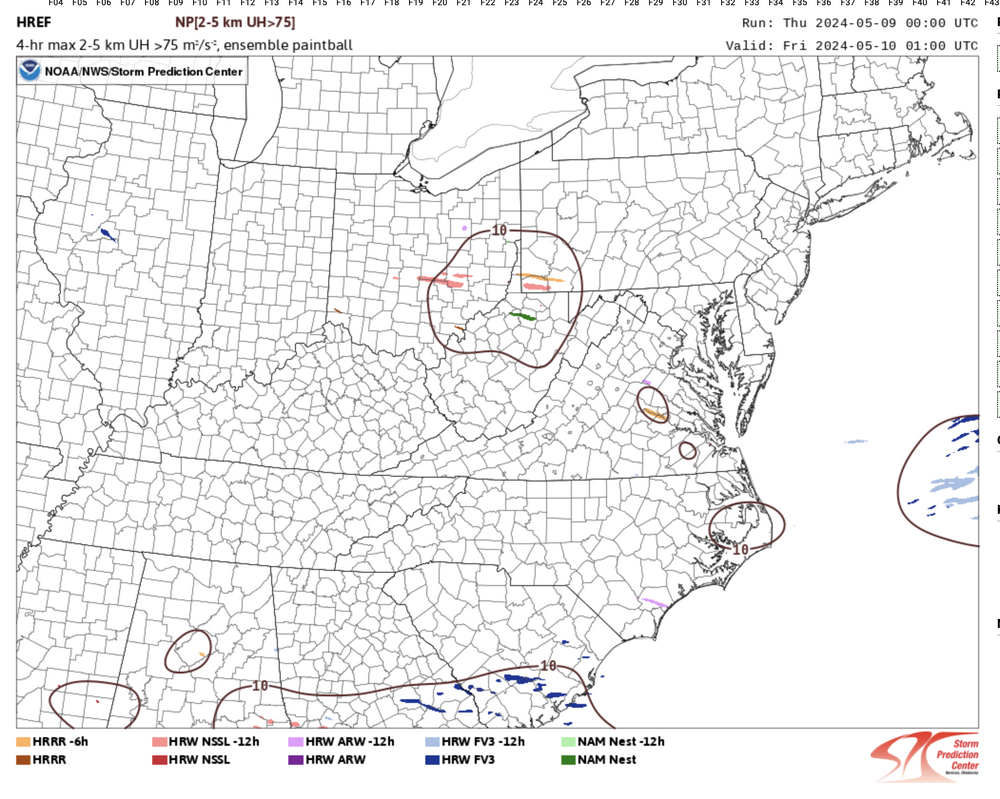-
Posts
3,017 -
Joined
-
Last visited
Content Type
Profiles
Blogs
Forums
American Weather
Media Demo
Store
Gallery
Everything posted by high risk
-
I'm going to toss the HiResWs (which don't assimilate ongoing rain) and focus on the NAM Nest and HRRR. Both show some limited airmass recovery this afternoon generally north of DC and generate at least a few storms across northern and central MD towards dinner time. Surface winds are veered, so unless a storm finds an outflow boundary, the tornado threat is likely lower, but IF we can get heating, the shear would support at least isolated instances of damaging wind.
- 1,696 replies
-
- 6
-

-
- severe
- thunderstorms
- (and 5 more)
-
Still a ton of uncertainty in the 00Z CAM suite. Several solutions fire convection late morning / midday.
- 1,696 replies
-
- severe
- thunderstorms
- (and 5 more)
-
The HRRR keeps wanting to kill it just before it reaches the Potomac. That said, while I think that there is a limited life for this thing, the HRRR is slow with the movement, so I could see it making it a bit further east.
- 1,696 replies
-
- severe
- thunderstorms
- (and 5 more)
-
Yeah, that line will still pack a punch for at least several more hours as it moves east across northern VA and western MD. The question is how far east it can advance as it encounters decreasing instability. Different HRRR cycles have shown it dramatically weakening in the western suburbs, as it crosses the Potomac, or over central MD. Some severe wind into at least part of the immediate DC area is certainly on the table.
- 1,696 replies
-
- 4
-

-
- severe
- thunderstorms
- (and 5 more)
-
Everything you wrote about the HRRR and NAM Nest is correct, but I don't think that tomorrow is about mixing. It's about clouds and convection from lead shortwaves. The NAM Nest is a round of storms late tonight and a second round in the very early afternoon, but the second round is mostly south and southeast. The northern areas therefore recover enough during the day for a good round of storms at the end of the day. The HRRR has the early morning stuff, and then round 2 around midday is more expansive. It still warms up behind it, but the surface winds veer, and there is little convergence along the front except in far northern MD, where the HRRR does have a round 3 at the end of the day. I won't go through every CAM, but the keys are heating and wind direction by mid afternoon. If we are heating and the winds are southwesterly, a big late day show is unlikely. If we are heating and the winds are more southerly, I think we'll have at least some coverage of SVR.
- 1,696 replies
-
- 7
-

-

-
- severe
- thunderstorms
- (and 5 more)
-
Put me down for 5/15/15. If we went entirely off of the NAM Nest, it would be an ENH for sure, but several CAMs have some morning or midday convection that ruin the lapse rates.
- 1,696 replies
-
- 3
-

-
- severe
- thunderstorms
- (and 5 more)
-
Seems like the GFS wants to break out convection during the morning which kills lapse rates and heating later in the day. The NAM is dry in the morning, and noted by @yoda, the environment at peak heating looks quite good, with nice backing of the low-level winds too. GFS does seem to be a bit of an outlier. My guess is that unless the 00Z ECMWF looks like the GFS, we'll have a Day 3 SLGT when we wake up Saturday morning.
- 1,696 replies
-
- severe
- thunderstorms
- (and 5 more)
-
I"m surprised. We heard thunder in North Laurel and then again in the Oakland Mills area of Columbia. We were also able to see lightning from the cell up near York after dark. Some signal in the CAMs for a few storms around later tonight, although I'm not sure what would trigger them.
-
It's worth noting that SPC used to be very liberal with issuing Moderate Risks. We had 3 here in a two-week period in some year in the early 2000s. They eventually added the Enhanced category so that they could save the Moderate for legitimate higher-end events.
- 1,696 replies
-
- 4
-

-
- severe
- thunderstorms
- (and 5 more)
-
Yeah, that was a cool event. There were definitely several tornadoes in the local area, although none of them were strong, as I recall. One tracked very close to Fort Meade.
- 1,696 replies
-
- 1
-

-
- severe
- thunderstorms
- (and 5 more)
-
Monday definitely has potential. SPC hinted at some timing issues in their discussion, and I would definitely prefer the faster progression of the upper wave depicted on the 00Z ECMWF.
- 1,696 replies
-
- 3
-

-

-
- severe
- thunderstorms
- (and 5 more)
-
That watch box comes further east than I expected
- 1,696 replies
-
- 4
-

-
- severe
- thunderstorms
- (and 5 more)
-
Definitely no more of the large region-wide area of rain that we had this morning, but some places are still going to get quite wet early this afternoon. There is some good agreement in the guidance for several areas of steadier showers, and the radar is starting to fill in a bit over northern VA.
-
Maybe? The GFS dries things out quickly, but most of the regional models stay wet until much later in the afternoon. But yeah, either way it won't be a good afternoon for outside stuff.
-
After looking at the evening guidance, I still have little confidence in a Saturday forecast, although the trend for those of us east of the Potomac seems to be wetter.
-
That's a very bullish forecast. It certainly seems like the best chances of heavy weekend rain are in the western and southwestern parts of the area, but depending on model of choice, heavy rain is far from a lock even there:
-
Right, but northern stream events here early in the season often struggle with instability, as it's tough to get good low-level moisture north at this time of year without some help.
- 1,696 replies
-
- 3
-

-
- severe
- thunderstorms
- (and 5 more)
-
Not only were there a couple of confirmed tornadoes in Garrett County Saturday, but the SPC storm reports list effectively shows a regional mini-outbreak. Quite remarkable for an event without a watch box.
- 1,696 replies
-
- 3
-

-
- severe
- thunderstorms
- (and 5 more)
-
models are very emphatic that the warm air is going to be confined to areas well south and west of DC. The trends in the HREF to eliminate the SVR risk in the DC area are quite clear: 12Z yesterday: 00Z today:
- 1,696 replies
-
- severe
- thunderstorms
- (and 5 more)
-
The HRRR was really the only model that ever went all in on this scenario, but it really backed off yesterday evening.
- 1,696 replies
-
- 1
-

-
- severe
- thunderstorms
- (and 5 more)
-
I think there is some clear potential for higher end events like that in the LWX CWA, but it's going to be limited to the extreme southern part of their area unless the models start moving the warm sector back further north
- 1,696 replies
-
- severe
- thunderstorms
- (and 5 more)
-
The afternoon NAM Nest and HRRR both suggest that SVR potential Thursday will be confined to south of a line from CHO to NYG. LWX basically agrees in their afternoon discussion.
- 1,696 replies
-
- severe
- thunderstorms
- (and 5 more)
-
I thought that the 12Z CAMs took a step back in the threat for tomorrow, with most showing much cooler temps locally, at least partially driven by early morning rain/clouds.
- 1,696 replies
-
- severe
- thunderstorms
- (and 5 more)
-
The 12Z NAM Nest now looks very much like that Euro run and has an explicit forecast of organized convection here Thursday in a fairly good environment.
- 1,696 replies
-
- 5
-

-
- severe
- thunderstorms
- (and 5 more)
-
That would favor severe for sure, but the problem is that the ECMWF for now is alone in depicting southerly winds over the Mid-Atlantic.
- 1,696 replies
-
- 1
-

-
- severe
- thunderstorms
- (and 5 more)





